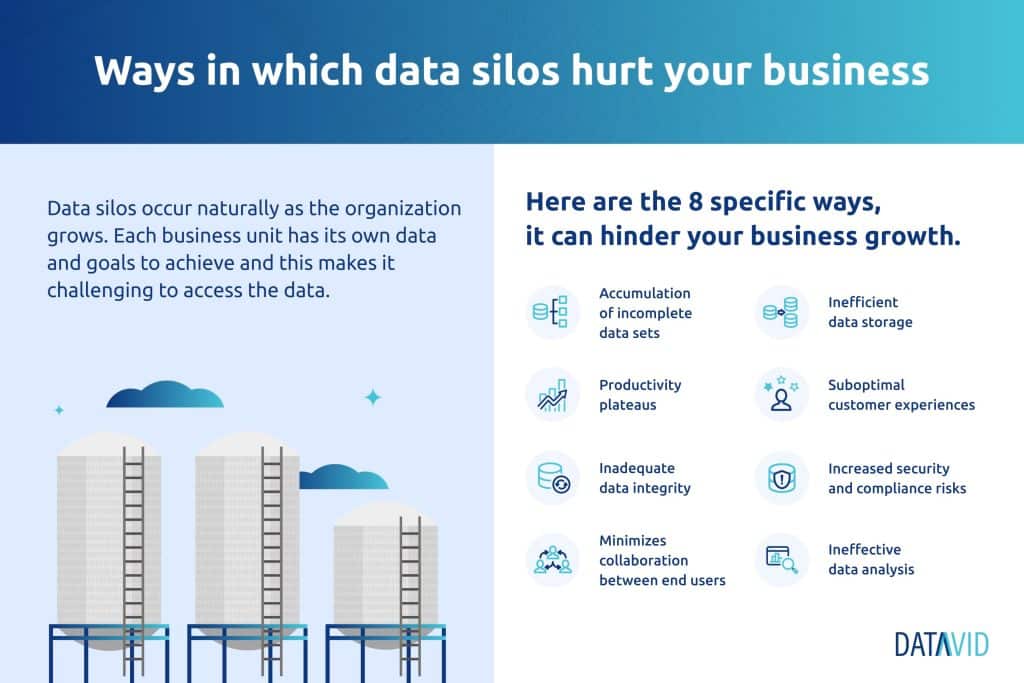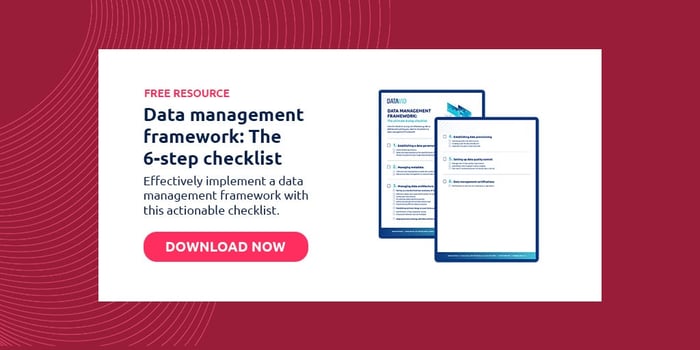4 minute read
Follow these 7 steps to eliminate data silos completely [Guide]
Data silos are problematic for the free flow of information in enterprises. Here are 7 steps on how to eliminate data silos completely.
Table of contents
Data silos form a set of raw or processed data that is not accessible to all departments within the organization.
Most companies might perceive that data silos are natural trends in their activities.
Unfortunately, data that is not accessible to all teams in your company can have an insidious effect on your business and prevent you from reaching your potential.

How to eliminate data silos effectively
Data experts know that silos have negative impacts on companies, such as:
- Providing an incomplete view of business information
- Creating a less collaborative environment
- Leading to bad customer experiences
- Wasting storage space
- Threatening the integrity and accuracy of your data
- Slowing the pace of your business
Currently, it’s clear organizations must find ways to break down data silos and allow for the free flow of information within the organization.
Here’s how you can eliminate data silos effectively:
Step #1: Centralize your data
Aggregating data into a single lake or data warehouse is a unique technique for crushing data silos in your business.
As it stands, the majority of companies are investing huge resources in SaaS providers, data stores, and on-premise solutions.
Unfortunately, all the huge investment in software seems to facilitate the problem of data silos rather than eliminating it.
The majority of this software doesn’t talk to one another.
Migrating your data to a central repository can eliminate data silos and make your operations seamless.
A central data repository comes with multiple benefits:
- Data is accessible in one location
- It protects sensitive information
- Data storage and management expenses are reduced
- It cuts down time-to-insight for IT teams
A robust data discovery platform like Datavid Rover can bring your data under one roof and cater to the needs of every employee or department in your enterprise.
Step #2: Use integration software
For some businesses, bringing data under one roof is practically not feasible.
That’s why such companies choose to keep their data in different pieces of software.
If your business uses multiple software to keep data, integrating that software correctly can help you avoid data silos.
By integrating these systems, you’ll have a single platform that gives you a comprehensive picture of your business and customers.
Integration is critical in updating your data while ensuring your different teams are on the same page. This approach companies are using to create a better customer experience.
Step #3: Weed out outdated data
It is daunting to go through all the accumulated data in your business.
However, you don’t need to continue spending money storing and protecting data that is not relevant to your business operations.
Weeding outdated and isolated data is a welcome technique for eliminating data silos.
You want your company to create a data management system that is usable and relevant to your current operations.
Have your employees go through the data and weed out the unnecessary.
This can double as a team-building strategy.
Besides getting current and accurate data, you’ll build strong relationships with employees in your organization.
Step #4: Change the organizational culture
In many businesses, departments tend to operate in isolation.
They’ve their processes, terminology, and even challenges.
This culture of departmental separation carries over to data, where each department keeps its data separate from other departments.
You can help break this data management approach by building organizational culture through open communication, supporting cross-departmental work, and sharing crucial information.
Allow your departments to build trust, togetherness, and team effort to enhance organizational goals.
The culture of internal competition should be eliminated because it builds strong data silos and directs organizational energy in the wrong areas.
For example, you cannot separate sales and marketing data.
The two departments must work together and share actionable information that builds potential leads that culminate into sales.
Step #5: Unit business managers
Getting buy-in from various team members is the most crucial strategy in ensuring data silos are eliminated in your business.
You should start at the top.
Departmental heads and other team leaders must set the tone for departmental collaboration.
They need to communicate why data silos are a danger to the organization’s progress and how they affect data integrity.
They must also highlight the appropriate techniques that the organization will use to address such problems completely.
If all the leaders and departmental heads have bought into eliminating data silos in the company, the process will be seamless and successful.
Step #6: Make it a company strategy
As discussed above, data silos emerge in organizations due to built-in systems that hinder collaboration between teams.
A unique and strategic method of breaking down data silos in your entity is making it a part of your business strategy.
You need to recognize that you have a major problem that can easily hurt your organization.
It will be easier to review and fundamentally change how your business is structured.
For example, you can look for creative ways of increasing the flow of communication between all levels of your organization.
You can go to the extra step of merging related departments and making collaboration one of your employees’ key performance indicators.
Step #7: Create uniform data sheets
Creating a single source of truth can extinguish data silos completely.
For example, you should pay attention to the various data departments create and collect. Say, for example, timesheet data.
If each department in your business is recording its timesheet, it’s hard to get a conclusive view of how much time each department spends on various tasks.
Using a single timesheet tool to collect data will give a standardized report about how time is spent in the organization rather than relying on multiple sources.
The problem of data silos
As organizations continue to grow, data silos have emerged as significant threats.
Various enterprise companies have been restricted from accessing their data, which is crucial in decision-making.
As a business executive, this is something you want to avoid. Incorporating the strategies above will help you break down data silos in your company.
Full data integration is possible through knowledge engines like Datavid Rover, which leads to increased cost-effectiveness, increased productivity, and quicker corporate growth.
Frequently asked questions
Data silos are problematic because they create barriers and inefficiencies in accessing and utilizing data. They lead to fragmented information, lack of data visibility, duplication of efforts, and hinder collaboration across teams and departments. Data silos limit the ability to gain holistic insights, make informed decisions, and leverage the full potential of data-driven technologies.
Eliminating data silos means breaking down the barriers and inefficiencies that prevent seamless data sharing and collaboration within an organization. It involves integrating data sources, systems, and departments to create a unified and accessible data ecosystem that promotes better insights, decision-making, and operational efficiency.
The three types of silos are departmental silos, system silos, and data silos.





